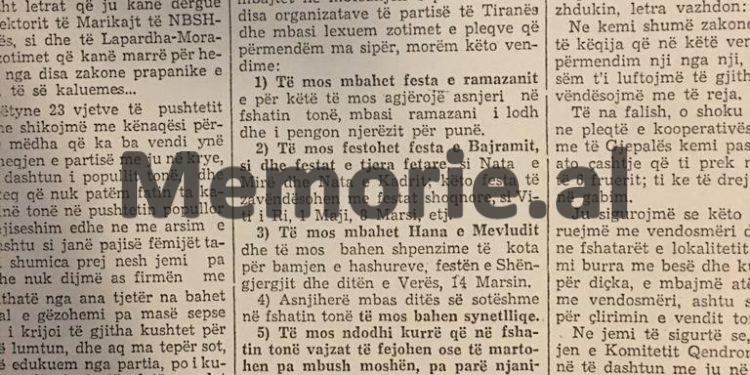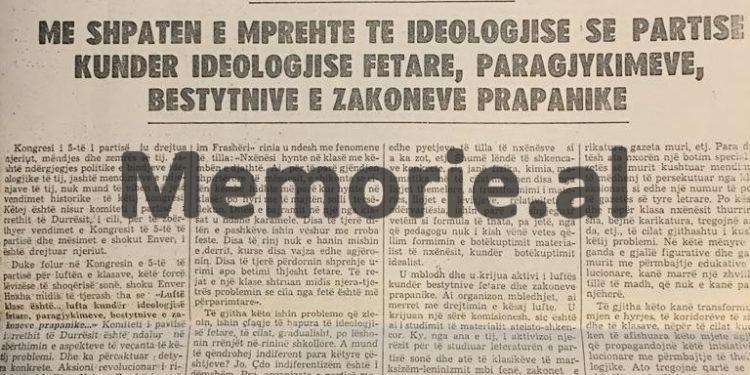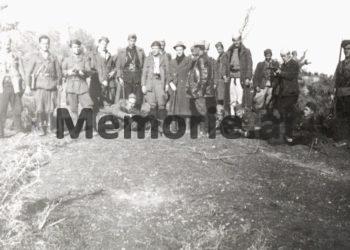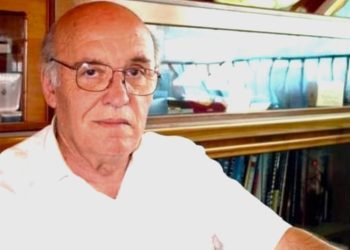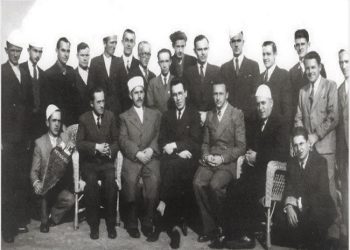Dashnor Kaloçi
Memorie.al publishes the unknown story of Irene Banushi, the senior cleric of the Albanian Autocephalous Orthodox Church, who is 1967, when the communist regime of Enver Hoxha organized and incited schoolchildren to demolish cult objects, it happened in Ardenica Monastery, where he had been interned for a long time and was able to stop the destruction of that building of great value. The whole life story of Bishop Banushi, from his origin and family, education at the College of Franciscans of Shkodra and then in Cetinje, near the Orthodox Seminary, coming to Albania and engaging as a publicist in some of the most popular newspapers of the period Zog’s monarchy, the arrest and internment of Italians as anti-fascists, as well as the arrests and internments of the communist regime in Tirana and the many vicissitudes and sufferings he had in the district of Lushnja, where he spent a large part of his life as a clergyman.
“After forcibly entering the interior, breaking the old doors, they started the destruction and broke the big candlestick of the church, where there were ancient objects with great historical and aristocratic values (unique perhaps in Europe), made by the brothers. Zografi and Konstandin Shapataraku. At this time, the monks who were there immediately called Irine (who was interned there), who went quickly and called on them to stop the destruction. With tears in his eyes and the intelligence that characterized him, he addressed them, “Come out, boys, what are you doing? Come on, let’s agree once and for all, eat a piece of bread and talk.” After these words, they stopped the violations they were committing and Ireneu spoke softly, telling them and the teachers who accompanied them, that that Monastery should not be destroyed, because it was a rare monument of Albanian culture “. Xhovan Gallani, the son of the famous teacher Vasil Gallani, one of the people who wrote a long letter to Enver Hoxha in 1967, testifies for the first time for Memorie.al, arguing that the Monastery of Ardenica, was in the spring of that year, schoolchildren near the monastery, with a communist teacher at the helm, with pickaxes in their hands had begun to demolish it, but who had been stopped by Irene Banushi, the well-known Bishop who was interned for years near that famous cult object. Who was Irene Banushi, what was the origin of his family, where was he educated, what career did he have in the Orthodox Church, why was he interned by the Italians and then twice sentenced to political imprisonment by the communists ?! Regarding this and others, this article introduces us, where we used the memories of Irene Banushi herself and the testimonies of Pandeli Stringa and Giovanni Gallani, two of his close friends, during the period he served in the Lushnja district as an orthodox clergyman. and as a worker in several enterprises of that district, after the communist regime had stopped religious beliefs.
The origin of Irene and his schooling
Irene Banushi, or Ilia, as his real name was, was born on 18.VIII.1906 in the city of Shkodra and was the youngest of his brothers. The Banushi family, from 1895, returned from Romania and settled in the village of Fikas in Elbasan, where they stayed for a short time, after being put in great economic difficulties and forced to move from there, to settle in the city of Shkodra, in the Rus Vogël neighborhood. Ireneu, after finishing primary school and an urban class in the “People’s School”, continued the “Ylliricum” gymnasium of the Franciscans in the city of Shkodra. He then continued his studies at the Orthodox Seminary of Cetinje in Montenegro, graduating in 1931. Being one of the good students of that school, Irene gave him the right to continue his higher studies at the Faculty of Theology. The University of Belgrade, where he graduated in 1938. After returning from Belgrade, he was appointed by the Presidency of the Albanian Orthodox Autocephalous Church, as a professor at the National Seminary “Apostle Paul” and at the same time, the Ministry of Education of that time, appointed professor at the State Gymnasium in Tirana, for the subject of History and Latin Language. In addition to teaching in these schools, Ireneu did not forget his passion for music, which he had practiced since high school at the College of Franciscans in the city of Shkodra, and when he came to Tirana, he became active in the choir of the Orthodox Church... Regarding his passion for music, in his memoirs, Ireneu, among other things, wrote: “According to my feelings, I have a penchant for vocal music and even more so for ecclesiastical music.” Since his arrival in Tirana, in addition to the work of the Church, Ireneu has been involved in journalism where he became very famous with the articles he published in the newspapers and magazines of that time, such as: “Ngjalllja”, “Tomorri”, “Bashkimi”, “Preaching”, “Christian life”, etc., where he addressed the problems that Albanian society was going through in those years. In the years 1938′-39, Irenaeus not only became very well known for his puppetry activity but in intellectual circles, he was considered a great patriot, one of the elite people of the capital, because of his progressive views. he displayed them in the press of the time.
Arrested by Italians and interned
With the invasion of Albania by fascist Italy, Ireneu was one of those people that the secret fascist services had put on the lists of people who had to be interned. In this regard, in his memoirs, he wrote: “The arrival of the occupier found me in Tirana, and in August 1939, the Italian authorities arrested me and kept me isolated for a month. Then they sent me to the city of Shkodra, where they held me for 25 days and then sent me back to Tirana, where they held me for another four days. After these walks from Shkodra to Tirana, I was interned in Italy, in a Mantua property. The Italians never told me the reason for my arrest. At the beginning of June 1940, I was returned to Albania, where I was released, but until the beginning of the school year, I lost my job. When we had three months left until the end of the 1941 school year, I was reappointed professor and worked until January 15, 1942, ”Irene Banushi recalled in his notes on the time he was arrested by the Italians. In January 1942, the Albanian Autocephalous Orthodox Church and personally the Archbishop, Archbishop Christopher Kissi, proposed to Irene to enter clerical life, and within a few months he ascended the steps of the religious hierarchy, being appointed Bishop of Apollonia, where he name Irene. The award ceremony took place on March 7, 1943, at St. Naum Monastery on the shores of Lake Ohrid. Regarding his appointment to that position, the magazine “Christian Life” in its first issue of 1942, wrote: in the Archdiocese, they reserved a spontaneous reception “. Likewise, the magazine “Christian Life”, in its seventh issue of the same year, wrote, among other things: “On Saturday, November 12, His Grace, Monsignor Ireneu, went to Shkodra. He had gone out of town to receive many clergymen on behalf of the Orthodox Community, led by the Metropolitan’s deputy. Another commission headed by the well-known Franciscan patriot and writer, Father Anton Harapi, who wished His Grace a welcome on behalf of the Albanian Franciscans, near whom His Grace graduated from high school.
Arrested by communists
At the end of 1944, the communist regime that came to power did not look favorably on Bishop Banushi, even though he had been interned by the Italians as an anti-fascist ?! In one of the information that the State Security had sent to Tirana for Irene, it was said: “During the occupation, he favored the National Liberation Movement, because his circle was with the Movement, but he himself was very reserved. With the liberation of Albania, we see that it begins to help but later withdraws. He was allegedly affected by the arrests and convictions of traitors. Many times he did not fail to say: “This court, with what right does it punish, as long as there are no laws and statutes” ?! At the beginning of 1945, Irene was appointed to go as Bishop of the Diocese of Gjirokastra, but the communist regime did not allow him to go and he stayed in Tirana, near the Presidency of the Orthodox Church. This happened after he was under surveillance by the State Security, who on October 28, 1946, arrested him on charges of “enemy of the people” and after nearly six months of torture in the Tirana Investigation, on April 17, 1947. , was sentenced by the court to 5 years of political imprisonment. He did not serve his full sentence because he benefited from an amnesty granted in April 1949, after what became known as the “Party Turn”, in which some political prisoners were released as “victims of Koci Xoxa”… After his release from prison, he was admitted to the Sanatorium in Tirana because he fell ill with tuberculosis and was later isolated in the Monastery of St. Vlash on the outskirts of Durrës.
Second arrest, five years in prison
After his release from prison in the early 1950s, Ireneu took part in drafting the statute of the Orthodox Church, where he faced many difficulties, as at that time the communist government intervened in all its forms to make that statute in his interests. his. From this situation, Irenaeus tried to escape what he could from the rights of the Church, by categorically rejecting the violation of the rights of religion. This became the main reason why he was not summoned to the Third Congress of the Albanian Autocephalous Orthodox Church, after the interventions that the State Security had made to the main leaders of the Orthodox Church of that time. In addition, Irenaeus refused to take part in the surrender of the new Bishops, because that was contrary to the statute of the Church and as a result, on August 22, 1952 (a day before the celebration of the feast of his name). , came his second arrest. After a lengthy investigation, on April 9, 1953, he was sentenced to five years in a political prison. Ireneu served his second sentence and was released from prison on August 25, 1957. After that he was interned in the Ardenica Monastery, where he lived in complete solitude and deep poverty. In that Monastery, the communist state did not allow Irene to perform religious rites as a Bishop, but since he had been a political prisoner, he was allowed to perform those rites only as a simple priest. During the years that Irene stayed there (he was slow to move out of the district without the approval of the Interior Ministry), he studied and gathered a lot of information about the history of Ardenica and its famous Monastery of the people who served there. which was built around the 13th century and where Skanderbeg had laid the crown of marriage. During those years that Irene lived in that Monastery, he received moral and material help from the villagers of that area, who honored and respected him with a special adoration.
How did you protect the Ardenica Monastery?
In 1967, after the communist regime decided to ban religion, at the behest of Party District Committees, dozens of young people were urged to go to churches, mosques, and other places of worship to destroy them. and to turn them into “Vatra Kulture”, cooperative warehouses, as it really happened with the most native part of the cult objects throughout the country. At this time, a large group of students from the 8-year school in the village of Kolonjë (located near the Monastery), equipped with pickaxes and shovels and led by a teacher (a member of the ALP of that school) went to demolish the Monastery. In this regard, Giovanni Gallani, (the son of teacher Vasil Gallani, a close friend of Irene’s) testifies: there were ancient objects of great historical and aristocratic value (unique perhaps in Europe as well), made by the brothers Zografi and Konstandin Shapataraku. At this time, the monks who were there immediately called Irine (who was interned there), who went quickly and called on them to stop the destruction. With tears in his eyes and the intelligence that characterized him, he addressed them, “Come out, boys, what are you doing? Come on, let’s agree once and for all, eat a piece of bread and talk.” After these words, they stopped the violations they were committing and Irene spoke softly, telling them and the teachers who accompanied them that that Monastery should not be destroyed, because it was a rare monument of Albanian culture. After that, the students obeyed, changed their minds, and left the Monastery, without further ado. Based on this situation, Ireneu talked to my father, Vasili, who wrote a letter to Enver Hoxha, explaining the great importance of Bitola, as well as the reasons why it should not be destroyed. Only after that, the Ardenica Monastery was able to escape the great devastation of 1967 “, recalls Giovanni, adding that this was made possible only thanks to Irene Banushi, who was interned there.
He died in misery in 1973
Around 1967, Irineu left the priest’s clothes with tears in his eyes and decided to live in the city of Lushnja, where he was assigned as a warehouse worker in the Railway Construction Company and then as a warehouseman and accountant in the Vehicle Park… Although he was able to adjust to these jobs, with the meager income he earned, he could barely afford to live and was regularly monitored by the State Security. In this regard, Pandeli Stringa, one of the people who knew him intimately and who had a close friendship with Irene during the years he lived in Lushnja, recalled: I met him almost every night, as he had been a friend of my father, Lawyer, Dr. Spiro Stringës. My friendship with Uncle Irineu was disliked by the “Party Eye,” who sent word to me that I would no longer associate with the “priest,” as he was called. Because he was a “declassed man.” The truth is that I accompanied Uncle Irine on walks on Lushnja Boulevard and in parks and gardens, where we talked for hours about music, literature, history, where he was a deep connoisseur of those fields and I listened to him. attentively. During the years that Uncle Irineu lived in the city of Lushnja (although he was pursued by the Security), he was revered and respected by almost the entire city, especially the families: Gallani, Syllari, Mone, Çabej, Korça, and the Libohova brothers. These families took him home for lunch and dinner, as they appreciated him: sincerity, generosity, intelligence, and the great culture he possessed “, recalled Pandeli Stringa, regarding the great respect that Irene Banushi enjoyed in the district of Lushnja. Although seriously ill, Irineu continued to work to provide for his livelihood until the early 1970s. Around 1973, his health deteriorated and after some interventions by his benefactors and granddaughter Vitoria, who had taken her to her home, he was brought to Tirana to be treated. But then it was too late and Irene Banushi passed away on November 25, 1973. Many friendly friends accompanied his lifeless body from Tirana to his simple home where he was given all due respect and secrecy. even religious ceremonies. His burial, according to his will, took place in Tirana, where he had performed the greatest activity as a High Priest of the Autocephalous Orthodox Church. After the 1990s, his close friend Pandeli Stringa arranged his grave in the Sharra cemetery, taking a bag with him and from the Ardenica Monastery, where he lived for many years after he had managed to save him from the complete destruction of vandals in 1967.
Memorie.al




